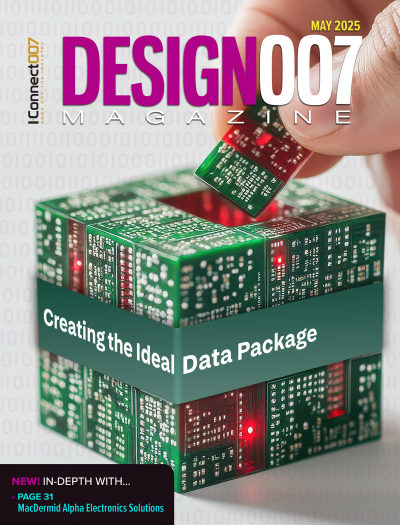-

- News
- Books
Featured Books
- design007 Magazine
Latest Issues
Current Issue
Showing Some Constraint
A strong design constraint strategy carefully balances a wide range of electrical and manufacturing trade-offs. This month, we explore the key requirements, common challenges, and best practices behind building an effective constraint strategy.

All About That Route
Most designers favor manual routing, but today's interactive autorouters may be changing designers' minds by allowing users more direct control. In this issue, our expert contributors discuss a variety of manual and autorouting strategies.

Creating the Ideal Data Package
Why is it so difficult to create the ideal data package? Many of these simple errors can be alleviated by paying attention to detail—and knowing what issues to look out for. So, this month, our experts weigh in on the best practices for creating the ideal design data package for your design.
- Articles
- Columns
- Links
- Media kit
||| MENU - design007 Magazine
BGA Fanout Routing Overview
September 4, 2018 | Christian Keller, AltiumEstimated reading time: 1 minute
PCB developers are deluged with new challenges caused by increasing density and smaller components. Ball grid arrays (BGAs) create particular challenges during layout, with hundreds of connections in just a few square centimeters. Fortunately, designers now have options for addressing these issues.
Fanout and Escape Routing
Because of the density and distance from the connection points, only the two outermost rows of a BGA can be connected directly to surface circuit traces. All other terminals of the BGA cannot be connected in a direct path on the surface.
Fanout and escape routing is integrated in many PCB design systems to enable further connections. In fanout and escape routing, the two outermost rows, and all other rows of a BGA, are automatically connected to the center of the terminals via a short circuit trace that is executed at a 45° angle. This provides a blind via that forms a direct connection to the next signal layer. Routing can be executed on the next signal layer.
Using via-in-pad eliminates the need for the additional trace to the center of the connections, thereby creating additional space for circuit traces. Therefore, with via-in-pad, the through contact can be placed directly at the terminal of the BGA.
During circuit board manufacturing, these through contacts will be filled with a non-conducting medium and cured. Later, the ends are metallized, planarized, and also over-contacted. This makes the surface of the via flat and can be used the contacts of the BGA. This solution can be used for both stacked and staggered microvias and/or blind vias. IPC-4761 describes how via-in-pads, for example filled and capped vias (IPC-4761 Type VII), are prepared. Despite the higher manufacturing costs, via in pads will always be preferred, because of the higher integration density of BGAs and their lower inductance at high frequencies (signal quality).
To read this entire article, which appeared in the August 2018 issue of Design007 Magazine, click here.
Testimonial
"In a year when every marketing dollar mattered, I chose to keep I-Connect007 in our 2025 plan. Their commitment to high-quality, insightful content aligns with Koh Young’s values and helps readers navigate a changing industry. "
Brent Fischthal - Koh YoungSuggested Items
Creating Connections in Mexico
07/30/2025 | Michelle Te, Community MagazineA concerted effort by the Global Electronics Association—Mexico team over the past year has created inroads for the Global Electronics Association (formerly IPC) with leading electronics companies, government offices, and academic institutions in Mexico. “Our goal is to bring more awareness to what the Global Electronics Association is and what it offers,” says Lorena Villanueva, senior director. “We also aim to increase our membership. Of 3,200 members of the Global Electronics Association, only 180 are in Mexico.”
Powering Progress: Summer 2025 Community Magazine Now Available
07/22/2025 | Community MagazineIn the new Summer 2025 edition of Community Magazine, members of the Global Electronics Association demonstrate what progress really looks like—through innovation on the factory floor, influence on public policy, and investment in the next generation of engineers.
TRI to Exhibit at SMTA Queretaro Expo 2025
07/16/2025 | TRITest Research, Inc. (TRI), the leading provider of test and inspection systems for the electronics manufacturing industry, is pleased to announce plans to exhibit at the SMTA Querétaro Expo 2025, scheduled to take place on July 24, 2025, at the Querétaro Centro de Congresos y Teatro Metropolitano.
Global PCB Connections: Let the Spec Fit the Board, Not Just the Brand
07/17/2025 | Jerome Larez -- Column: Global PCB ConnectionsIf you’ve ever seen an excellent PCB quote delayed, or worse, go cold because of a single line on the fab print, you’re not alone. Often, that line reads something like, “Use 370HR only,” or “IT-180A required.” These and other brand-name materials are proven performers, but unless your design needs that specific resin system (say, for RF performance, thermal reliability, or stringent CAF resistance), you may inadvertently be holding your job hostage.
IPC Hall of Fame Spotlight Series: Highlighting Lionel Fullwood
07/15/2025 | Dan Feinberg, I-Connect007Many IPC members who have contributed significantly to IPC and our industry have been awarded the IPC Raymond E. Pritchard Hall of Fame (HOF) Award. Though many early HOF members have passed away and are unknown to today’s IPC membership, their contributions still resonate. This special series on IPC Hall of Fame members provides a reminder of who was honored and why. As a bonus, for those who are still around, we get to find out what these talented individuals are up to today.


